DID YOU KNOW?
The Eclectus Parrot species was split in 2019 to four new taxa: Moluccan, Papuan, Tanimbar and Sumba Eclectus.

Eclectus

roratus
Size:
35 cm (13.6 in)
Weight:
450-600 g (15.75-21 oz)
Subspecies including nominate:
Two: E. r. roratus, E. r. vosmaeri
Colour Adult:
E.r. roratus (Grand Eclectus): Male-green with red underwing coverts to sides of belly; central tail feathers green above and tipped yellow/white, side tail feathers green and washed blue above and tipped yellow/white; undertail grey tipped yellow/white, upper mandible orange tipped with yellow, lower mandible black. Eye orange. Female-body red with dark brown/red on back and wings; underwing coverts to lower breast, abdomen and wide band across mantle soft purple; red of upper breast washing into purple of lower breast; bend of wing lilac/blue; undertail coverts red with longer feathers tipped yellow; tail red tipped orange/yellow. Beak black. Eye yellow/white.
E.r. vosmaeri: Male-as in roratus, but head, neck and undertail coverts more yellow; side tail feathers blue edged with green; larger. Female-as in roratus but undertail coverts yellow; tail widely tipped with yellow; larger.
Colour Juvenile:
As in adults but duller; in both sexes upper mandible dark brown/grey tipped yellow. Eye brown.
Call:
In flight: loud, rough screech repeated continuously or in short bursts. Various alarm calls, more mellow calls and a bell-like sound possibly heard before mating.
More Information:
Content Sources:
BirdLife International
Cornell Lab of Ornithology/Birds of the World
Parrots of the World, Forshaw, 2010.
Parrots in Aviculture, Low, 1992.
Captive Status:
Fairly common in aviculture.
Longevity:
May live up to 50 years.
Housing:
Aviary or suspended cage, minimum length 3 m (9.8 ft).
Diet:
Fruit, any type but especially apple, pear, orange, cactus fruits, pomegranate, banana, forming about 30 percent of diet; fresh vegetables especially carrot, celery, green peas, beans, fresh corn and green leaves. Cooked/sprouted beans or pulses. Spray millet, mix of small seeds (canary, millet, small amounts of oats, buckwheat, safflower, limited sunflower) and complete kibble.
Enrichment:
Bird-safe chew toys, branches, puzzle toys, bathing, peek-a-boo games, swings, ropes.
Nest Box Size:
30 cm (11.7″) square and 1.2 m (4 ft) high, or 12″x 12″x 24″ (30.5 cm x 30.5 cm x 61 cm) vertical box.
Clutch Size:
2
Fledging Age:
11 weeks.
Hatch Weight:
—
Peak Weight:
—
Weaning Weight:
—
World Population:
7300-51,000 mature individuals, decreasing.
IUCN Red List Status:
Least Concern
CITES Listing:
Appendix II
Threat Summary:
Threatened by trapping for the wildlife trade and hunting. The population on Obi has been severely impacted by trade. A recent estimate suggests 810 (+/- 153) individuals are harvested annually for trade on Obi alone and while this estimate is thought to be high, the population there is in significant decline.
Range:
Restricted to the Moluccas, being known from the islands of Morotai, Halmahera, Ternate, Bacan, Obi and other small islands; also Buru, Seram, Ambon, Haruku and Saparua.
Habitat:
Occupies the canopy of all wooded habitats, most commonly primary lowland forest but is also found in mangroves, Nypa palm forest, freshwater swamp, dryland forest, coastal scrub, denser savanna woodland, parkland, plantations, secondary growth and garden areas.
Wild Diet:
Diet consists of fruits, seeds, nuts, leaf-buds and blossoms, mainly Parinarium and Pandanus.
Ecology and Behaviour:
Birds are found singly, in pairs or small groups. Often found soaring high above the forest calling loudly. Wary; foraging groups found in treetops. Mostly active at dawn and dusk traveling to and from roosting areas where up to 80 birds will settle in for rest.
Clutch and Egg Size:
2 broad and ovate shaped, 40.0 x 31.0 mm (1.5 x 1.2 in).
Breeding Season:
August-September. Nest is in tree cavity.
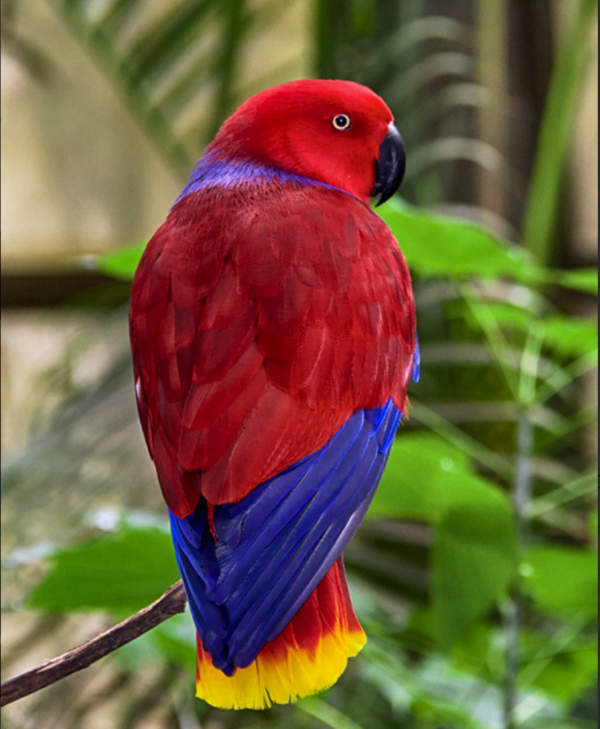
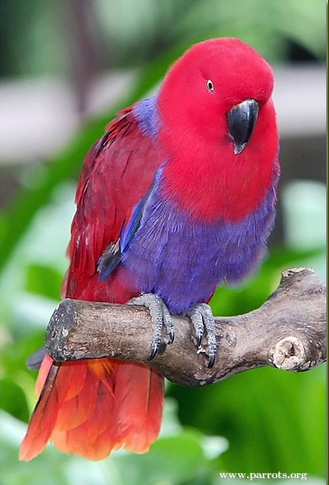
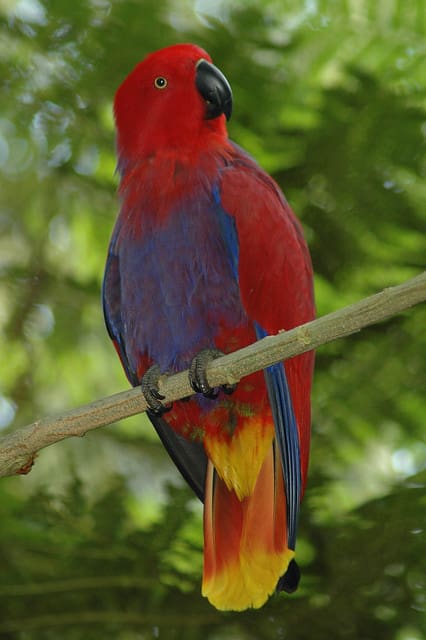
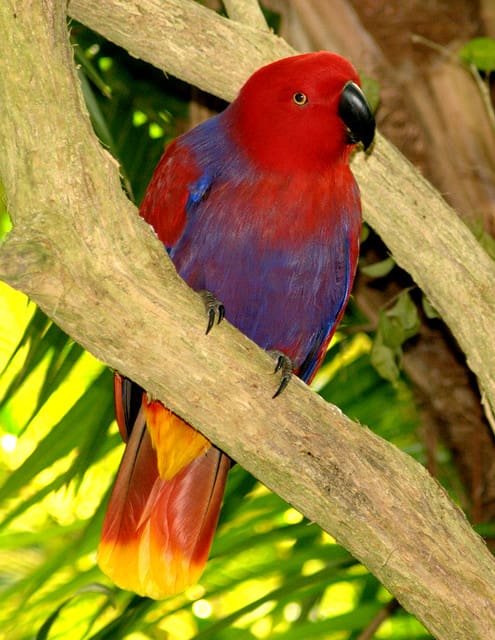
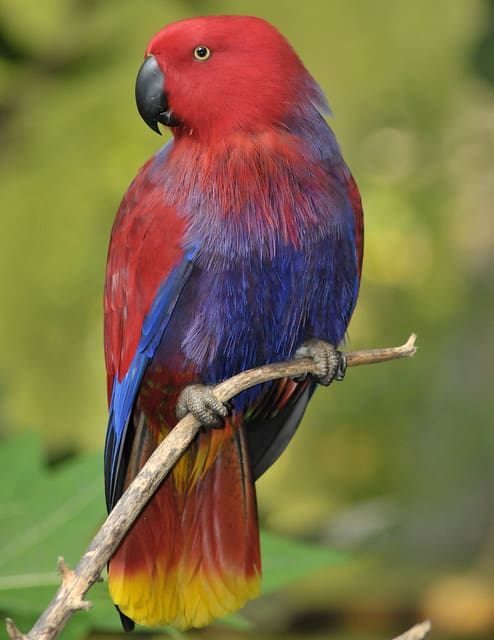
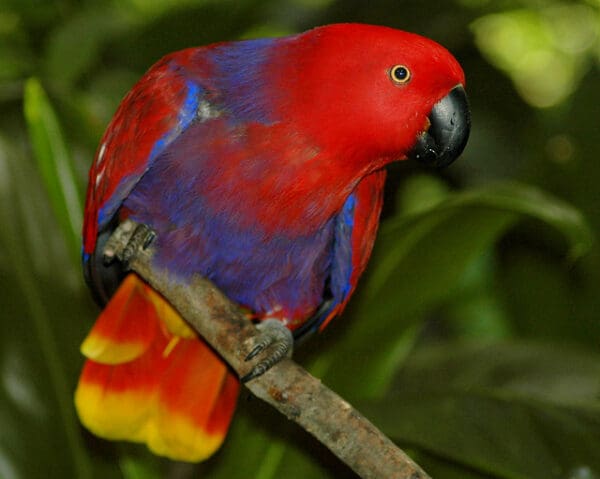
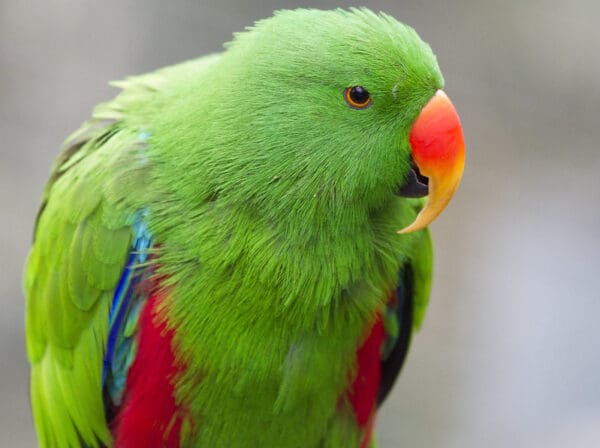
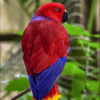
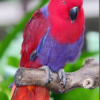
![© Valerie [CC BY-NC-ND 2.0] via Flickr A female Moluccan Eclectus perches on a limb](https://parrots.org/wp-content/uploads/2023/01/wpt_Moluccan-Eclectus_2170-6-100x100.jpg)
![© Valerie [CC BY-NC-ND 2.0] via Flickr A female Moluccan Eclectus perches on a limb](https://parrots.org/wp-content/uploads/2023/01/wpt_Moluccan-Eclectus_2170-5-100x100.jpg)
![© Valerie [CC BY-NC-ND 2.0] via Flickr A female Moluccan Eclectus perches on a twig](https://parrots.org/wp-content/uploads/2023/01/wpt_Moluccan-Eclectus_2170-3-100x100.jpg)
![© Valerie [CC BY-NC-ND 2.0] via Flickr A female Moluccan Eclectus perches in a tree](https://parrots.org/wp-content/uploads/2023/01/wpt_Moluccan-Eclectus_2170-2-100x100.jpg)
![© Nathan Rupert [CC BY-NC-ND 2.0] via Flickr A closeup of a male Moluccan Eclectus](https://parrots.org/wp-content/uploads/2023/01/wpt_Moluccan-Eclectus_2170-1-100x100.jpg)